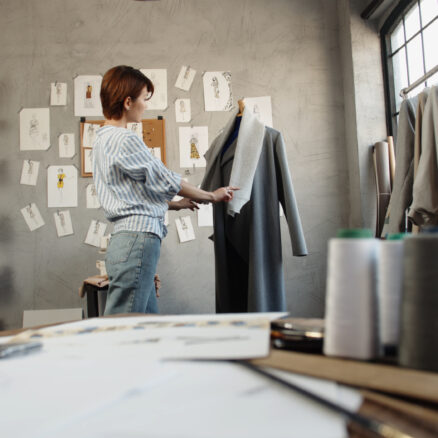Circularity is top-of-mind for many fashion and sporting goods brands as they explore ways to reduce impacts and make good on climate, biodiversity, water and waste commitments. Opportunities for disruption and transformational change abound, but aligning the industry with planetary boundaries will be less about how we adapt our current system and more about how brands will challenge their current business models to shape a new future for fashion. This is the second in a series of articles (here and there) exploring the different approaches for system-level transformation in the industry.
In brief:
- The current “take-make-discard” model is unsustainable if we are to live within planetary boundaries.
- But circularity is not a silver bullet. Sustainability must be integrated into each phase of a product’s lifecycle.
- Many companies embrace ecodesign principles or use LCA assessments to guide impact reductions. Going circular requires business model change.
- Circularity should not be driven in isolation, but rather fully integrated into the broader business strategy and fully aligned with longer-term sustainability commitments.
Circularity has become the go-to buzzword in sustainability circles recently — and for good reason. Creating “well-designed products that create less waste and last longer” (to take European Commission President Ursula von der Leyen’s definition) symbolizes the gold standard for responsible business.
To recap: a circular approach is rooted in lifecycle thinking. It’s about considering the lifetime of a product and how it might (or might not) become waste in the future. It’s about developing products that might be reused, repaired or recycled at the end of their lifetime. But more than that, it’s about diminishing the use of raw materials, decoupling their exploitation from growth and radically changing business models.
However, circularity is not a silver bullet and should not be seen as a panacea to our sustainability challenges. Companies should not only transition to developing sustainable product portfolios (a huge feat in itself) but also integrating sustainability at each phase of any product lifecycle. That’s the only way we can ensure “ecodesign” leads to the transformation we need across brands and entire industries.
Our linear model is broken
So, why is a circular approach so important? Well, the current linear ‘make-use-discard’ model is unsustainable if we are to live within planetary boundaries, the set of nine parameters established by the Stockholm Resilience Centre (SRC) within which humanity can continue to develop and thrive for generations. Exceed them, and we’re in trouble.
Right now, our economies are dominated by linear business models. In fact, across the EU, just 12% of secondary materials and resources are being brought back into the economy. “Many products break down too easily, cannot be reused, repaired or recycled, or are made for single use only,” says Executive Vice-President for the European Green Deal, Frans Timmermans. “There is a huge potential to be exploited both for businesses and consumers.”
Many companies have stepped up to the challenge, using ecodesign principles to reduce the environmental impact of their products at different stages of life. Some are switching up their choices of raw materials, to make them more durable. Some are focused on end-of-life. Some are focused on the use phase. For example, in food, the focus has been on upcycling (using foodstuffs that would have been wasted as raw materials). In fashion, a number of brands are looking to make garments that need to be washed less. In cosmetics, product developers are exploring ‘leave on’ makeup.
But ecodesign alone will not drive the market toward circularity, especially when conducted in piecemeal fashion. Going circular implies business model change. It requires companies to not only rethink their products (what is offered and how it is produced), but also their marketing activities and how they engage with their consumers as well as other key players across the value chain. Across sectors, companies are taking a methodological approach to achieve circularity by mapping the lifecycles of their products using tried and tested Life Cycle Assessment (LCA) to quantify and trace the impacts of each production phase. Done right, an LCA can help companies better achieve long-term goals and ambitions by preventing burden shifting and ensuring that hard-to-measure impacts aren’t ignored.
A complex, yet critical, business
Reaching circularity is a complex business. First, it can be technically challenging, particularly for certain products such as fresh food. Some circular models may lead to more losses. Circularity can also present some social and cultural challenges, for both employees and consumers.
Circularity necessitates a shift in business culture, which is never easy. Changes to how product design is done means teams will have to integrate new constraints, knowledge and tools into their day-to-day work. Changing business models for niche products or as part of a pilot project is fine. But scaling that up to include entire portfolios can be a real challenge.
Then there are consumers to think about. Just because a brand has created circular products or services doesn’t mean buyers will engage and get excited. People need ongoing education and incentives to change their mindsets. In cosmetics, achieving circularity is mainly addressed through packaging. Making products reusable is about giving consumers a chance to refill containers — a situation made all the more complicated for hygiene, sanitary and logistic reasons.
In fashion, the focus is largely on design, in particular, selecting the right materials and designing for durability so that garments can be repaired, resold or refurbished. On its own, however, fiber recapture and reuse would, at best, achieve a 10% industry-wide emission reduction within the broader fashion value chain. The scale of impact reduction the industry must achieve within the next few years will only be possible with a combination of increased circular material flow, rapid transition to renewable energy sources, a significant increase in manufacturing progress efficiencies, and smart design.
Striking a delicate balance
Ultimately, achieving circularity is a balancing act, and companies must accept and acknowledge that circularity will not win every time from a cost perspective. However, it is up to them to challenge the status quo and aim for greatness.
The goal should never be to create a circular system for its own sake, but rather to pursue solutions and take actions that both minimize environmental impacts and maximize the creation of sustainable value. That means never forcing circular principles into a system designed for the linear economy. We call these “rebound effects.” One example of this would be creating an extensive logistic flow to recover materials which are not particularly localized at the end of their life and sending them to recycling sites. There is every chance that the carbon footprint in this exercise will far exceed producing new, virgin material in the first place. Another example would be putting in place a take-back system that ends up shortening the life cycle of a product, and ultimately encouraging overconsumption.
Radical rethinking: three essential elements for driving the circular paradigm shift
Every company needs to:
1. Engage consumers to promote responsibility
Consumers’ mindsets — expressed by consumer behavior — are the starting point of circular consumption systems. The name of the game for brands is to encourage consumers to engage in different buying patterns, embrace new products and ways of communicating with brands. That’s because many of the strategies proposed for materials to cycle in the technical loop — reuse, repair, rework and recycling — depend on users’ decisions, particularly in fashion. Remember: circular behavior is not always entrenched in people’s consumption patterns, and circular solutions depend on overcoming cultural barriers.
However, circularity provides the opportunity for multiple touchpoints with consumers to engage, raise awareness of what’s important to a brand and create deeper and more dynamic relationships.
2. Take into account the broader ecosystem, where the regulator plays a critical role
The regulator will be increasingly important in fostering a suitable landscape that makes it easier to transition to circularity. The EU’s New Circular Economy Action Plan aims to “make circularity the mainstream in our lives and speed up the green transition of our economy.” The laws and policies that will emerge from it will help to establish a secondary raw materials market and offer companies appropriate incentives to speed up their circularity transition, e.g. environmental tax reform.
Regulation will also enable a more even playing field at a time when consumer trust is an incredibly valuable currency, reducing incidents of greenwashing.
3. Work with the supply chain, and embrace digitalization and technological innovation
Adopting a circular mindset can be akin to taking action to transform business models and operations. It can enable long-term decision-making and a focus on innovating to meet long-term goals. Any product portfolio transformation should be at the core of the business, covering the full value chain and include a measure of the impacts being addressed, whether environmental or social.
However, circularity is not only about improving performance based on these measurements. It’s a way of doing business, and as such, circularity must become an integral part of organizational culture. It’s about working with your R&D department to identify material options. It’s about working with marketing and sales to embrace new technologies. It’s about making every product design an ecodesign. It’s about making sustainability the default across the company at every stage in the process of bringing products to market.
Design for sustainability: embedding sustainability into every business choice
Circularity is about making products and services sustainable by design. This means rethinking business models to integrate environment into design, something that can be achieved by taking into account the entire life cycle of a product (including upstream, use and end of life) during the product development and design phase, avoiding the transfer of impact from one phase to another.
And don’t forget the crucially important role of consumers, who are, in fact, critical partners in delivering sustainable transformation change. We all are the market; we all can contribute to its change.



